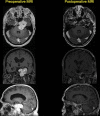Transcavernous Approach for Gross Total Resection of a Dumbbell-Shaped Giant Trigeminal Schwannoma
- PMID: 36068896
- PMCID: PMC9440937
- DOI: 10.1055/s-0041-1729995
Transcavernous Approach for Gross Total Resection of a Dumbbell-Shaped Giant Trigeminal Schwannoma
Abstract
Trigeminal schwannomas are rare nerve sheet tumors that represent the second most common intracranial site of occurrence after vestibular nerve origins. Microsurgical resection of giant dumbbell-shaped trigeminal schwannomas often requires complex skull base approaches. The extradural transcavernous approach is effective for the resection of these giant tumors involving the cavernous sinus. The patient is a 72-year-old man with headache, dizziness, imbalance, and cognitive decline. Neurological examination revealed left-sided sixth nerve palsy, a diminished corneal reflex, and wasting of temporalis muscle. Magnetic resonance imaging (MRI) showed a giant homogeneously enhancing dumbbell-shaped extra-axial mass centered within the left cavernous sinus, Meckel's cave, and the petrous apex, with extension to the cerebellopontine angle. There was a significant mass effect on the brain stem causing hydrocephalus. Computed tomography (CT) scan showed erosion of the petrous apex resulting in partial anterior autopetrosectomy ( Figs. 1 and 2 ). The decision was made to proceed with tumor resection using a transcavernous approach. Gross total resection was achieved. The surgery and postoperative course were uneventful, and the patient woke up the same as in the preoperative period. MRI confirmed gross total resection of the tumor. The histopathology was a trigeminal schwannoma, World Health Organization (WHO) grade I. The patient continues to do well without any recurrence at 15-month follow-up. This video demonstrates important steps of the microsurgical skull base techniques for resection of these challenging tumors. The link to the video can be found at https://youtu.be/TMK5363836M.
Keywords: dumbbell-shaped; extradural transcavernous approach; skull base; transpetrosal transtentorial approach; trigeminal schwannoma.
The Author(s). This is an open access article published by Thieme under the terms of the Creative Commons Attribution-NonDerivative-NonCommercial License, permitting copying and reproduction so long as the original work is given appropriate credit. Contents may not be used for commercial purposes, or adapted, remixed, transformed or built upon. ( https://creativecommons.org/licenses/by-nc-nd/4.0/ ).
Conflict of interest statement
Conflict of Interest None declared.
Figures


LinkOut - more resources
Full Text Sources
Miscellaneous

